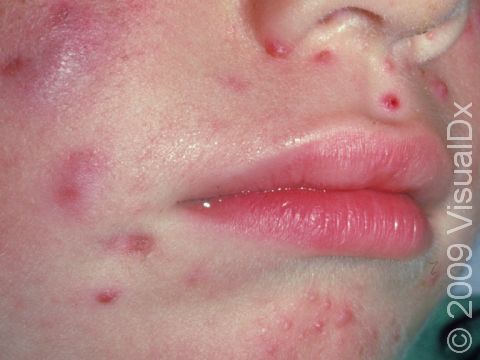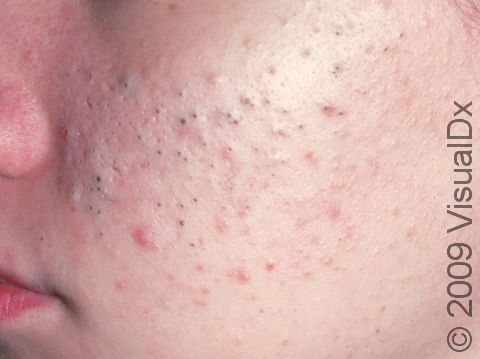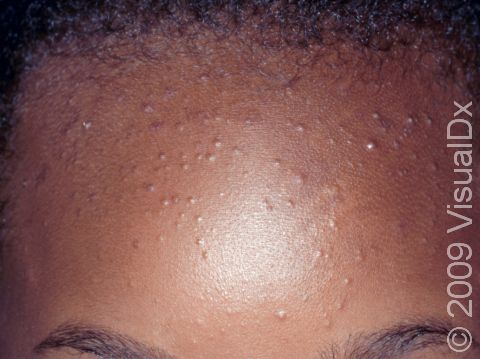Acne (Acne Vulgaris)
Acne, also known as acne vulgaris, is a common skin condition that can affect people of all ages, including children.
Acne is often hereditary, meaning it runs in families. While there is no cure for acne, almost all acne can be improved by simple measures and treatments your child’s doctor can recommend.
There is no cure for acne, but certain steps can help prevent more breakouts. Acne can result in scarring, so minimizing breakouts is important.
Who's At Risk?
Acne affects 85%-100% of people at some point in their lives. While it usually begins at puberty, it can start even earlier. Acne is uncommon in children younger than 8 years, but it can occur because of a hormonal imbalance and certain medications. People of all races / ethnicities get acne.
Signs & Symptoms
Acne most commonly occurs on the face, neck, chest, and back, where the most sebaceous glands are located. Acne lesions can be blackheads (open comedones), whiteheads (closed comedones), papules, pustules, and nodules / cysts. Papules are small, smooth, solid bumps that may be pink or red in lighter skin colors or darker red, maroon, or brown in darker skin colors. Pustules are pus-filled lesions, and nodules and cysts are larger and deeper than papules.
Mild acne consists of a few papules / pustules and sometimes comedones. Moderate acne has an increased number of these lesions. Severe acne has numerous comedones, papules, pustules, and may have painful nodules and cysts.
Acne can result in permanent scars, which can appear to be depressions in the skin or hyperpigmentation, which appears as brown, flat marks where the acne lesions were. This skin color change may be more pronounced or last longer in darker skin.
Self-Care Guidelines
If your child has a hormonal imbalance, treating it will help resolve the acne lesions.
Cleanse the acne-prone areas with gentle soaps or cleansers. Avoid irritants such as rubbing and other alcohols, abrasive scrubs, and greasy products on the skin and the scalp. Products labeled “water-based” or “noncomedogenic” will help reduce clogged pores.
There are also a variety of over-the-counter medications that may help. These are meant to be preventive therapies and should be applied in a thin layer to the entire area on a regular basis. If applied consistently, you may see small improvements quickly, but results are generally seen after a few months. Children have sensitive skin and may experience very drying side effects from these medications. For drier skin, use a weaker concentration of benzoyl peroxide; for oily skin, consider higher strengths. Be careful, as benzoyl peroxide can bleach clothing and towels. Peeling agents (exfoliants), such as salicylic acid, can also help.
Treatments
If your child has not reached puberty, blood tests might be done to look for a hormone imbalance.
Topical treatments include creams, washes, or gels, such as:
- Antibacterial agents such as clindamycin (Cleocin T), erythromycin (AkneMycin), sulfur, sodium sulfacetamide (Liquimat, Sulpho-Lac), dapsone (Aczone) in children ages 9 years and older, and azelaic acid (Azelex, Finacea) in children ages 12 years and older.
- Retinoids – vitamin A-based products such as tretinoin (Retin-A), tazarotene (Avage, Tazorac), and adapalene (Differin).
Oral (internal) treatments may include antibiotics.
Visit Urgency
Children younger than 8 years with acne should be seen by their medical professional to investigate its causes, such as a hormone imbalance or a medication side effect.
If your child is 8 years or older and has moderate or severe acne that has not improved effectively with self-care, seek medical help.
References
Bolognia J, Schaffer JV, Cerroni L. Dermatology. 4th ed. Philadelphia, PA: Elsevier; 2018.
James WD, Elston D, Treat JR, Rosenbach MA. Andrew’s Diseases of the Skin. 13th ed. Philadelphia, PA: Elsevier; 2019.
Kang S, Amagai M, Bruckner AL, et al. Fitzpatrick’s Dermatology. 9th ed. New York, NY: McGraw-Hill Education; 2019.
Paller A, Mancini A. Paller and Mancini: Hurwitz Clinical Pediatric Dermatology. 6th ed. St. Louis, MO: Elsevier; 2022.
Last modified on June 13th, 2024 at 12:36 pm

Not sure what to look for?
Try our new Rash and Skin Condition Finder













